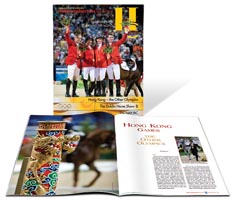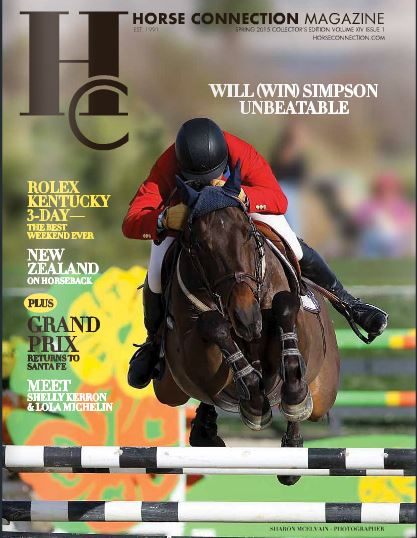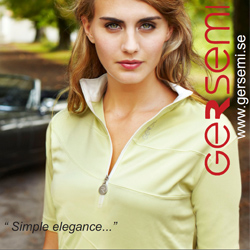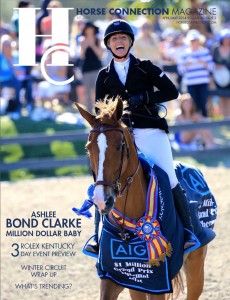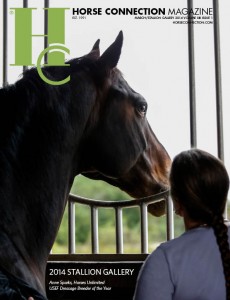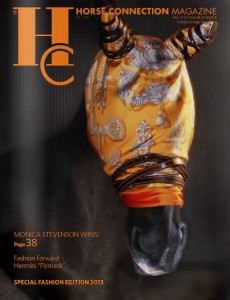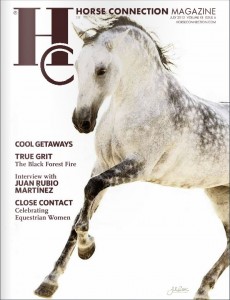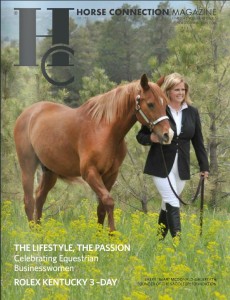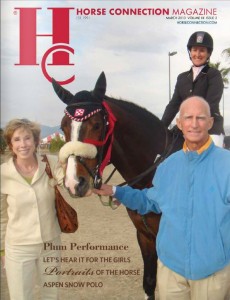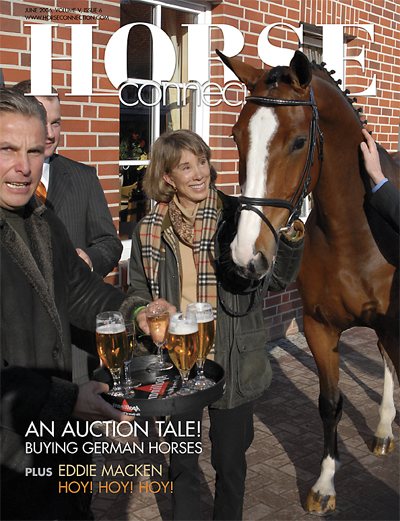
Shopping the Horse Country of Germany – June 2006
geoff young
all photos by geoff young
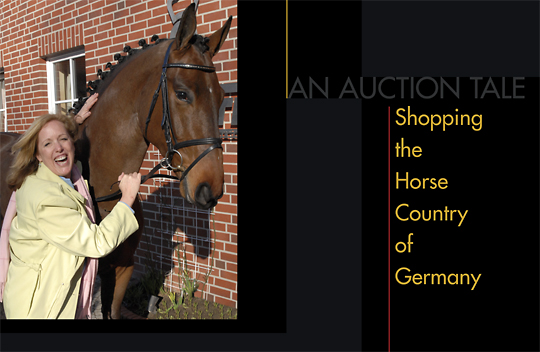 When Nancy Gooding asked Valerie and me if we wanted to go shopping with her, I thought, sure, I could use some new shirts. Twelve days later, at 43,000 feet above the spot where the Titanic went down in the North Atlantic, I saw the Northern Lights through the large oval window of the Gulfstream, and realized that we had embarked on the shopping trip of a lifetime.
When Nancy Gooding asked Valerie and me if we wanted to go shopping with her, I thought, sure, I could use some new shirts. Twelve days later, at 43,000 feet above the spot where the Titanic went down in the North Atlantic, I saw the Northern Lights through the large oval window of the Gulfstream, and realized that we had embarked on the shopping trip of a lifetime.
We touched down in Bremen, Germany, in the northern state of Lower Saxony, not far from the North Sea, but close to the center of the horse universe. The finest horses in the world are bred, raised, and trained in this region, and we were here to shop the trot, and possibly bring home a 1700 lb souvenir.
Nancy Gooding has been coming to Germany for over ten years, selecting horses and shipping them back to the U.S. to sell to riders who want the best horse flesh money can buy. Valerie and I were accompanying Nancy to get a real inside look at the spectacular horse auctions, and the equestrian facilities of this dynamic horse culture.
Hanoverian, Holsteiner, Oldenburg; these were the brands of the horses that we would look at, comparable to window shopping at only Tiffany’s, Versace, and Dolce. These brand name horses are the result of over a hundred years of careful breeding and management, and we were on a mission to attend three huge elite sales over the next two weeks.
We drove to the town of Vechta and settled in under rainy skies for three days of observing, evaluating, and bidding on Oldenburg horses at the Oldenburg Verband’s spring auction.
The Verband, or organization, was established to assist the German farmers in the selling and exposure of their horses to the marketplace. The Verband developed strict guidelines to maintain the characteristics and conformation of their specific horse, and its suitability for either dressage or jumping. They developed a tracking system of stallion bloodlines to ensure quality, and provided a place to hold auctions to sell the horses.
On Friday night we went to the Oldenburg Verband to see a preview of the horses that would be auctioned the next day. Buyers from all over the world were evaluating horses during the preview, because to go into a horse auction without doing your homework, is like ordering food off a German menu when you don’t know the language. You just don’t know what you’re going to get. I was guilty of one, but not the other. And the raw veal in cream sauce wasn’t that bad, especially if you had a big mug of German pilsner to chase it with. At least I wasn’t going to end up with a dressage horse when we were looking for a jumper.
It is really amazing what the riders that work for the Verband do to get these horses ready for auction. With just three weeks of training under saddle, these horses develop enough skill to jump and perform dressage so that their talent and potential can be showcased to the buying public.
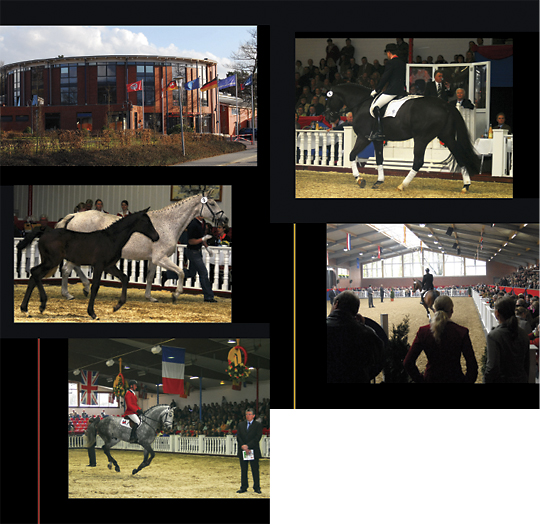 Saturday, April 1st, was no day for fools as we arrived at the Oldenburg Verband, eager and excited at attending our first German horse auction. As the dignified mares and beautiful foals were paraded before a packed crowd, I couldn’t help but be struck, as an American, by the irony of this event. In Germany, a horse auction is the start of a promising career for a sporthorse, whereas in the U.S., it more often than not, means the end of one.
Saturday, April 1st, was no day for fools as we arrived at the Oldenburg Verband, eager and excited at attending our first German horse auction. As the dignified mares and beautiful foals were paraded before a packed crowd, I couldn’t help but be struck, as an American, by the irony of this event. In Germany, a horse auction is the start of a promising career for a sporthorse, whereas in the U.S., it more often than not, means the end of one.
We sat in the VIP tent drinking champagne and sipping salmon soup as buyers from all over the world checked the auction book one final time to make sure that their notes and decisions were correct in regards to their impending purchase. The horses in this auction had bloodlines that read like a who’s who of the best jumping and dressage stallions in the world; Rubinstein I, Donnerhall, For Pleasure, Cor de la Bryere, Sandro, Landgraf I, Pik Bube, Grundstein, and Argentinus.
The auctioneer, Uwe Heckmann boomed a welcome to the visitors from all of the different countries as the music announced the first horse and rider. The first horse, Donatus Rex, was a magnificent 17.2 hands dressage horse with direct Donnerhall inbreeding through superstars Don Davidoff and Don Schufro, and his sale price reflected that, as a buyer from Great Britain paid 146,000 euros for the Oldenburg.
Uwe Heckmann is well known in these horse circles and he obviously recognized many of the bidders. Although he only spoke German, you could tell he was cajoling people, playing one against the other, and entertaining the rest of us with his innuendo, inflection, and showmanship.
The winning bidder would have champagne brought to their table, and usually some flowers. It was all very elegant with gorgeous athletic horses and riders, bouncing, jumping foals, and smiling faces as Uwe would point to the high bidder with the gavel and thunder, “Verkauft!”
It was all very exciting, but we weren’t ready to pull the trigger and make a bid on a horse just yet. We still had two auctions to attend, including the ESI auction the next day in Lastrup. This auction would be unforgettable, and would put a smile on my wife’s face bigger than the one she had the day we were married!
We headed to Lastrup, a village about 15 km southwest of Cloppenburg. We drove into the Valley of the Hase, named for the Hase river that runs through, past fields that were covered in canvas, hiding the delicacy “weiss spargle,” the famed white asparagus which I would later discover is a religious eating experience.
Everything closes down on Sunday in Germany, and Lastrup was no exception, which may be why there were so many people at the ESI Sportpferde Auktion (sporthorse auction). The food kiosks were in full grilling fury, and the beer and champagne flowed as people wandered into the VIP tents, and strolled the red brick walkways between the stables and the arena, and visited the Reitsport Schockmohle mobile tack store.
There is nothing quite like pommes frites fried in lard. They are without a doubt the best fries I have ever had, and with a huge dollop of mayonnaise on top and a tender rump steak with mushrooms to go with, it provided a Sunday meal fit for a King or a Chancellor. A mug of pilsner later and I was ready to preview the horses.
This auction featured only jumpers, and there were some fine looking horses going over the jumps as we sat in the stands with our auction book making notes. We acted as if we were definitely there to bid on a horse, but we hadn’t actually talked about it. Suddenly, out of the stalling area and into the arena cantered a big beautiful gelding with a very tall rider aboard. We looked at his number, and then looked it up in the book. His name was Salt and Pepper, and his bloodline was impressive, with Argentinus, Sandro, Ramino, Lanzette, and Grannus contributing to his foundation. The picture of Salt and Pepper in the auction book showed nice form over the jump, and importantly, a loose rein.
I read from the auction book. “He has a direct dam line of Autogramm with successful relatives being Anka and Sandro Boy, both ridden by Marcus Ehning.”
“He must be called Salt and Pepper because of his sire, Sergeant Pepper,” I said to Val. Her eyes got wide and she said, “there‘s the reason for his name.”
I looked at the dark bay Oldenburg in the ring and there it was in stark contrast to the black mane; a silver gray tail! We looked at each other and then back to the horse. It was stunning. I had never seen a horse with that kind of bling. No words were said, but Val started making notes in her auction book, and I had a funny feeling as she went off with our friend Nancy, to see the auction vet and look at radiographs.
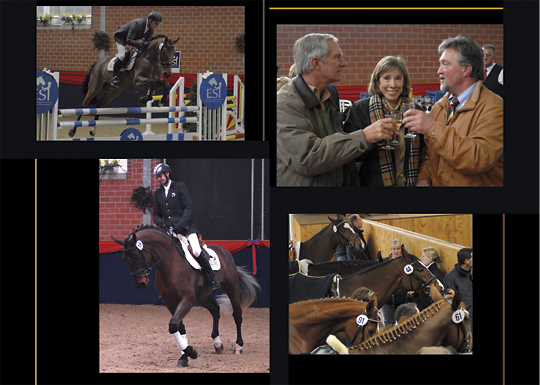 A couple of hours later the preview was over, and the auction was ready to start. We reserved a table along the ring and settled in for a fine Sunday afternoon of horse bidding, seasoned with anticipation.
A couple of hours later the preview was over, and the auction was ready to start. We reserved a table along the ring and settled in for a fine Sunday afternoon of horse bidding, seasoned with anticipation.
Hands in the air signaled action as horsemen from all over the world made their play in the red brick arena nestled in this German forest. I was busy taking pictures when Salt and Pepper came into the ring. The bidding was brisk, when I suddenly heard the auctioneer say, “Nancy’s friend has entered the bidding.”
I spun around and there was the love of my life with her hand in the air, albeit, a timid hand. It happened so fast that when I heard “sold,” I started applauding the person who had bought Salt and Pepper, not knowing that I was applauding myself.
A bouquet of flowers came to the table, and Val signed for the horse, our horse, and the champagne started flowing. It was an exciting moment and an adrenaline rush, and for us first timers, it was anything but business as usual. It was a thrill ride.
“Aren’t you happy?” yelled Val. “I’m half German,” I replied, trying to sound unemotional while muzzling the urge to jump into the air like a poker player with a chance at the final table.
A few moments later, with grins still on our faces, an audible buzz was coursing through the crowd, as some big players were furiously bidding for the gorgeous bay gelding, Palim Palim. The famous German horseman, Gilly Bockmann, was in on this horse as were several other bidders. As the bidding went up, the crowd started to get excited, and electricity was in the air as Palim Palim was going farther than any other horse had gone that day.
When the gavel came crashing down, the capacity crowd jumped to their feet in applause and whistles. Cameras swooped in around our table and auction officials came over to offer congratulations to the high bidder of this auction, our friend Nancy!
With Palim Palim’s owner in tears, and cradling many bottles of champagne, we went outside of the arena where Palim Palim and Salt and Pepper were brought out for a photo op. It was quite the spectacle, brown horses surrounded by red brick, and when Val posed with “Pepper,” the look on her face said it all. We had bought our first German horse at an auction, and it was one of the most memorable experiences of our lives.
Later that evening over lamb and white asparagus with hollandaise, we were still so giddy over the excitement of the day that I had to keep reminding Val how delicious the albino asparagus was.
We had one final auction to attend, and everything was happening so fast, or maybe it was just the fact that we were on the autobahn. We were headed to the charming horse town of Verden, home of the Hanoverian Verband, and our last auction.
 The horse culture is dominant in Verden. While we were walking about this beautiful town, I noticed bronze statues of foals, and bronze horseshoes that were inlaid in the sidewalk, forming a walk of fame. I stopped and looked down at the horseshoe in front of me. It was engraved with the name, Dr. Reiner Klimke. Klimke’s six gold and two bronze medals in dressage stands as the Olympic record for the equestrian events.
The horse culture is dominant in Verden. While we were walking about this beautiful town, I noticed bronze statues of foals, and bronze horseshoes that were inlaid in the sidewalk, forming a walk of fame. I stopped and looked down at the horseshoe in front of me. It was engraved with the name, Dr. Reiner Klimke. Klimke’s six gold and two bronze medals in dressage stands as the Olympic record for the equestrian events.
Val and I spent the rest of the afternoon at the Verband, previewing the horses, but mainly watching buyers from all over the world try out the horses. The preview arena was very small, but it was filled up with horses, riders, trainers, clients, and bankers (husbands).
It was intense as amateur riders jumped horses while others cantered right in front of the landing area. There were many close calls, and one woman, who was intent on trying out just about every jumper there was, had everyone stop in their tracks while she rode, just barely in control. I secretly hoped that she wasn’t American as one owner refused to let her get on his horse.
The Hanoverian auction is a huge affair with a spectacular gala and plenty of food, drink, mares, foals, stallions, and famous German equestrians. We attended the Friday night Gala at the Verband, and were treated to a very entertaining program featuring horses that would be up for auction the following day.
It is a novel idea to use the auction horses in the gala because it gives people another chance to see a particular horse in action. The numerous riders would enter the ring dressed in costumes, and with as many as 12 horses would execute beautiful dressage moves in patterns across the colorful arena.
One act after another entered the arena; a New Orleans band was followed by a Hawaiian-themed ride, followed by solo dressage presentations, Frisians, and ponies pulling children on unicycles.
Dressage star Isabella Werth was recognized in a ceremony that had her piaffing about before receiving a bouquet, and several German equestrian stars made appearances, including a jumping demonstration featuring Ludger Beerbaum, Marco Kutchner, and Lars Neiberg, followed by eventing star Bettina Hoy, who rode around the ring and waved at the crowd.
A special ceremony honored Elparso, a mare who was bought at this auction and later produced Shutterfly, Meredith Beerbaum’s spectacular horse. A foal was also raffled, and as I looked at my ticket, I wondered if there would be a carry-on bag big enough to get the little guy home.
The gala ended with horses riding to one of Mozart’s symphonies. It provided a glorious finish to a fantastic show, and was the best equine circus I had ever seen.
With large flower gardens in the arena and a Mercedes parked at one end, the 114th Elite Auction at the Hanoverian Verband commenced on Saturday. With the gavel never leaving his right hand, and constantly held aloft like a lightning rod, auctioneer Friedrich-Wilhelm Isernhagen got the electricity flowing the way he has for many years at this auction.
As the capacity crowd sat in the bleachers, enveloped by the haze from hundreds of chain smokers, the action was fast and furious. One table with buyers from Los Angeles made a large winning bid on a grey jumper mare, and the paparazzi swooped in to capture the moment as the horse posed in front of its new owners.
The auction moved at a brisk pace, and in about four hours it was over. The crowd moved out of the arena and down to where the food and drink were being served up. The mood was celebratory as farmers toasted the sale of their horses, and buyers toasted their entourages on their new steeds. Most of the crowds who show up for these auctions do so for the sheer spectacle and entertainment of the moment. It is part of their life and culture, and is a pretty nice way to spend a weekend.
The auctions in Germany are a fun and educational way to buy a horse. The convenience of an auction is that many of the logistics are taken care of. And there is always an advantage to having a large selection to choose from. The beers and brats aren’t too bad, either!
Our two week shopping trip to Germany was memorable in so many ways (and I did buy a couple of shirts), but especially so because we brought back Salt and Pepper, who will keep the memories of our trip alive every time we see him go in the ring. He is safe and sound back in Colorado, waiting to become the star we think he is. We will campaign him this summer, and report to you on the progress of this new immigrant to the USA. If you are on the show grounds this summer and see a horse with a grey and silver tail, stop by and say hi. After all, you know his name.

